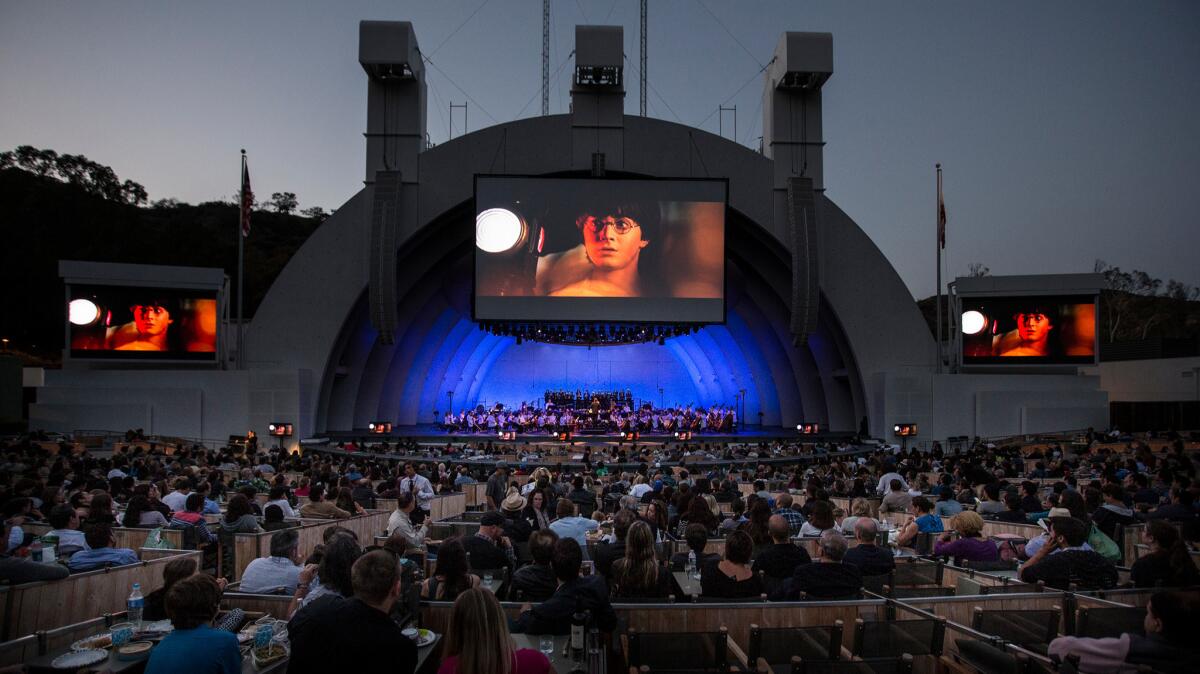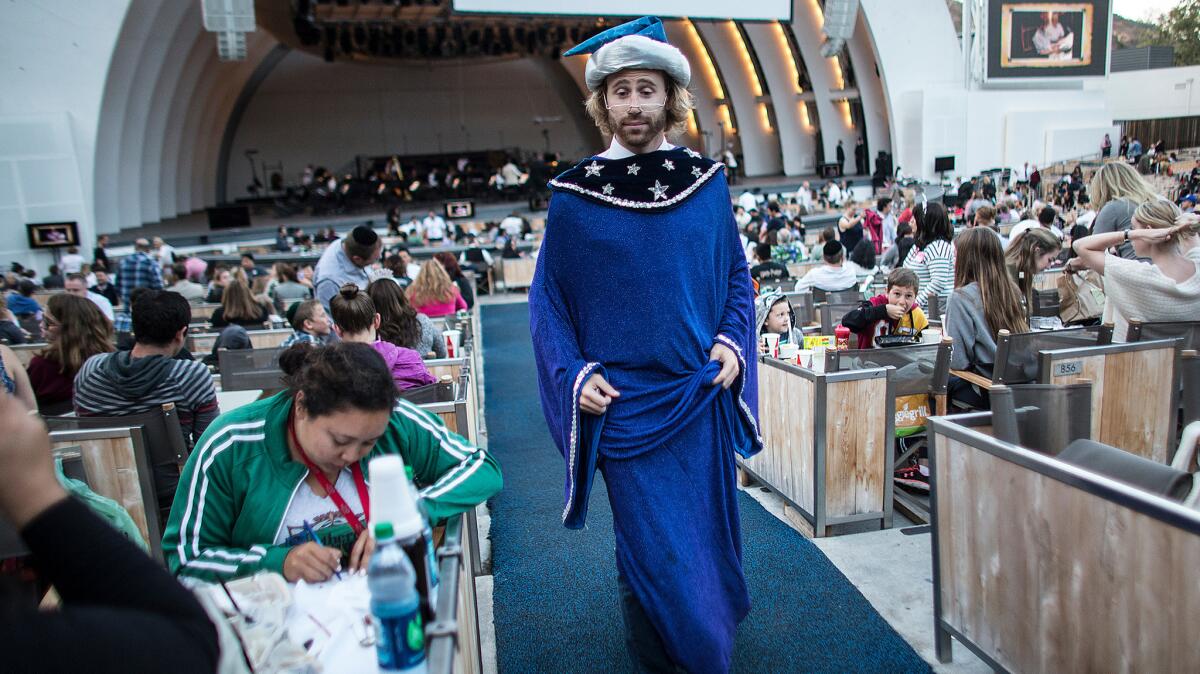Review: Ravenclaws represent at L.A. Phil’s ‘Harry Potter’ performance at the Hollywood Bowl

Who knew the world was so full of bright young Ravenclaws?
That was one revelation among many during Wednesday’s celebration of the world of Harry Potter at the Hollywood Bowl, an evening in which the Los Angeles Philharmonic performed John Williams’ movie score live during a screening of “Harry Potter and the Sorcerer’s Stone,” the inaugural film based on author J.K. Rowling’s blockbuster book series.
Fans, many of them outfitted in their Hogwarts School of Witchcraft and Wizardry finest, packed the house. As the film unfolded over three hours — including a 20-minute intermission — audience members cheered or booed the entrance of each of the story’s myriad characters.
It came across like a class reunion for this modern-day epic tale featuring a trio of young, magically savvy protagonists — Potter, Hermione Granger and Ron Weasley — and the Hogwarts staff, including headmaster Albus Dumbledore, magical creatures caretaker Rubeus Hagrid, academic staff members Minerva McGonagall and the dreaded Severus Snape all the way down to Mrs. Norris, the feline accomplice of the loathsome school caretaker Argus Filch.

That made the communal aspect as much a part of the evening as the screening and concert performance.
A predictable ovation erupted at the first mention of Gryffindor, one of the four houses within Hogwarts into which incoming students — Potter being its poster boy — are sorted for their seven-year education and training in all manner of supernatural subject matter.
An equally enthusiastic mix of cheers and boos accompanied the first reference to Slytherin, the house for clever and ambitious students such as the nefariously scheming Draco Malfoy and, before him, the malevolent dark wizard who eventually became Lord Voldemort.
The surprise was the voluminous greeting for Ravenclaw, the house for intelligent and witty adolescents, which nearly outdid the response for loyal Hufflepuff, matching or exceeding the cheers for Gryffindor and Slytherin.
The main event, however, was the opportunity to see the film and hear the music performed live, perhaps the only way to truly trump the home movie-going experience for so many people who have large-screen video monitors or projectors and surround-sound audio systems in their living rooms. Such events offer a real-world place for like-minded people to celebrate a shared interest, an increasingly rare opportunity in the world of entertainment that is personalized to the extreme.
Justin Freer led the orchestra and a 24-member choir with verve and attention to detail through the rigorous demands of Williams’ evocative score, which rarely gives an orchestra respite.
It reinforced just how indispensable the music is to this film, as it has been with so many other projects involving Williams, from the “Star Wars” and Indiana Jones franchises to the Christopher Reeve “Superman” films, “Jaws” and “E.T. The Extra-Terrestrial.”
The live performance brought into sharper relief the multiplicity of moods and emotions Williams elicited with the notes of the central Harry Potter theme when scored with different instrumental voices.
That motif is heroic yet conveying a tinge of sadness when given to the French horns, delightfully magical and lighthearted when coming from the celesta and bells. The same notes turn strikingly ominous when delivered by the trombones and lower brass, then signify inner strength and resilience when played by the violas and cellos.
Pizzicato strings mirrored the whimsicality of the Sorting Hat sequence, low woodwinds interacted playfully at the hatching of a baby dragon. Brass fanfares and flourishes announced the sporting thrill of the first onscreen Quidditch match, and anguished passages amplify the tragic discovery of slain unicorns when Hagrid and his young charges embark on a late-night foray into the Forbidden Forest.
Williams’ score is at its most disarming in the scene in which Harry sits before the Mirror of Erised, gazing forlornly at the ghostly images of his murdered parents, as Dumbledore arrives to comfort and mentor the young wizard on his heroic journey.
Next up at the Bowl this weekend are two nights of screenings of the 2009 “Star Trek” reboot, for which composer David Newman will lead the L.A. Phil performing Michael Giacchino’s score live. On Aug. 13, Orange County’s Pacific Symphony serves up another Williams score live for its outdoor screening of Steven Spielberg’s “Raiders of the Lost Ark.”
Yes, these events provide an added income stream and represent a way for orchestras to appeal to new audiences when they constantly struggle to fill seats with traditional classical programs. But it also allows the legion of Gryffindors, Slytherins, Hufflepuffs and Ravenclaws to get out of their bedrooms now and then and let their house colors fly.
Follow @RandyLewis2 on Twitter.com
For Classic Rock coverage, join us on Facebook
ALSO:
Harry Potter could make Universal Studios a real rival to Disneyland
Watch Cirque du Soleil reimagine the Beatles’ ‘While My Guitar Gently Weeps’
Ringo Starr and his All-Starr Band wrap 2016 tour but promise new music is on the horizon
More to Read
The biggest entertainment stories
Get our big stories about Hollywood, film, television, music, arts, culture and more right in your inbox as soon as they publish.
You may occasionally receive promotional content from the Los Angeles Times.






